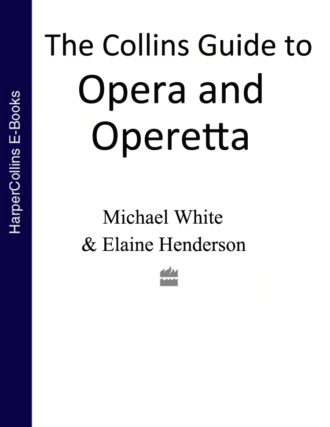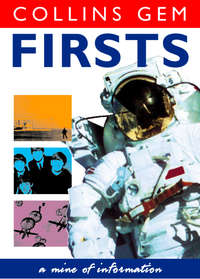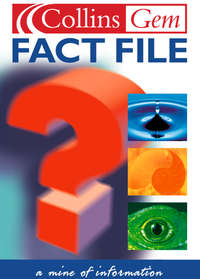
Полная версия
The Collins Guide To Opera And Operetta



Published by Collins, an imprint of HarperCollinsPublishers Ltd
1 London Bridge Street
London SE1 9GF
www.harpercollins.co.uk
First published in Great Britain by HarperCollins Publishers 1997
Copyright © 1997 Michael White and Elaine Henderson All rights reserved.
Michael White and Elaine Henderson assert the moral right to be identified as the authors of this work
A catalogue record for this book is available from the British Library
All rights reserved. This book is sold subject to the condition that it shall not, by way of trade or otherwise, be lent, re-sold, hired out or otherwise circulated without the publisher’s prior consent. No part of this text may be reproduced, transmitted, downloaded, reverse engineered, or stored in or introduced into any information storage and retrieval system, in any form or by any means whether electronic or mechanical, now known or hereinafter invented, without the express written permission of HarperCollins ebooks
HarperCollinsPublishers has made every reasonable effort to ensure that any picture content and written content in this ebook has been included or removed in accordance with the contractual and technological constraints in operation at the time of publication
Source ISBN: 9780004720616
Ebook Edition © MARCH 2018 ISBN: 9780008299538
Version: 2018-05-16
Contents

Cover
Title Page
Copyright
How to Use this Ebook
Introduction
John Adams
Nixon in China
Samuel Barber
Vanessa
Béla Bartók
Duke Bluebeard’s Castle
Ludwig van Beethoven
Fidelio
Vincenzo Bellini
Norma
I Puritani
La Sonnambula
Alban Berg
Lulu
Wozzeck
Hector Berlioz
Béatrice et Bénédict
Les Troyens
Leonard Bernstein
Candide
A Quiet Place
Harrison Birtwistle
Gawain
Punch and Judy
Georges Bizet
Carmen
Les Pêcheurs de Perles
Arrigo Boito
Mefistofele
Alexander Borodin
Prince Igor
Benjamin Britten
Albert Herring
Billy Budd
Death in Venice
Gloriana
A Midsummer Night’s Dream
Peter Grimes
The Rape of Lucretia
The Turn of the Screw
Alfredo Catalani
La Wally
Gustave Charpentier
Louise
Luigi Cherubini
Médée
Francesco Cilea
Adriana Lecouvreur
Domenico Cimarosa
Il Matrimonio Segreto
Peter Maxwell Davies
The Lighthouse
Claude Debussy
Pelléas et Mélisande
Léo Delibes
Lakmé
Gaetano Donizetti
Don Pasquale
L’Elisir d’Amore
La Fille du Régiment
Lucia di Lammermoor
Maria Stuarda
Antonin Dvořák
Rusalka
Gottfried von Einem
Dantons Tod
Manuel de Falla
La Vida Breve
John Gay
The Beggar’s Opera
George Gershwin
Porgy and Bess
Umberto Giordano
Andrea Chénier
Fedora
Philip Glass
Akhnaten
Mikhail Glinka
A Life for the Tsar
Ruslan and Lyudmila
Christoph Willibald Gluck
Alceste
Iphigénie en Tauride
Orfeo ed Euridice
Charles Gounod
Faust
Roméo et Juliette
George Frederick Handel
Alcina
Giulio Cesare
Semele
Serse
Tamerlano
Joseph Haydn
La Fedeltà Premiata
Hans Werner Henze
The Bassarids
Elegy for Young Lovers
Paul Hindemith
Mathis der Maler
Engelbert Humperdinck
Hänsel und Gretel
Leoš Janáček
The Cunning Little Vixen
The Excursions of Mr Brouček
From the House of the Dead
Jenůfa
Kátya Kabanová
The Makropulos Case
Oliver Knussen
Where the Wild Things Are
Erich Korngold
Die Tote Stadt
Franz Lehár
Die Lustige Witwe
Ruggero Leoncavallo
I Pagliacci
Heinrich August Marschner
Der Vampyr
Pietro Mascagni
Cavalleria Rusticana
Jules Massenet
Manon
Werther
Gian Carlo Menotti
Amahl and the Night Visitors
The Consul
Giacomo Meyerbeer
Les Huguenots
Claudio Monteverdi
La Favola d’Orfeo
L’lncoronazione di Poppea
Il Ritorno d’Ulisse in Patria
Wolfgang Amadeus Mozart
La Clemenza di Tito
Cosí fan Tutte
Don Giovanni
Die Entführung aus dem Serail
Idomeneo
Le Nozze di Figaro
Die Zauberflöte
Modest Musorgsky
Boris Godunov
Khovanshchina
Otto Nicolai
Die Lustigen Weiber von Windsor
Carl Nielsen
Maskarade
Jacques Offenbach
La Belle Hélène
Les Contes d’Hoffmann
Orphée aux Enfers
La Vie Parisienne
Francis Poulenc
Les Dialogues des Carmélites
La Voix Humaine
Sergei Prokofiev
The Fiery Angel
The Love for Three Oranges
War and Peace
Giacomo Puccini
La Bohème
La Fanciulla del West
Madama Butterfly
Manon Lescaut
Tosca
Il Trittico
Il Tabarro
Suor Angelica
Gianni Schicchi
Turandot
Henry Purcell
Dido and Aeneas
The Fairy Queen
King Arthur
Maurice Ravel
L’Enfant et les Sortilèges
L’Heure Espagnole
Nikolai Rimsky-Korsakov
The Golden Cockerel
The Legend of the Invisible City of Kitezh
Gioacchino Rossini
Il Barbiere di Siviglia
La Cenerentola
Guillaume Tell
L’ltaliana in Algeri
Camille Saint-Saëns
Samson et Dalila
Aulis Sallinen
The Red Line
Arnold Schoenberg
Moses und Aron
Dmitri Shostakovich
Lady Macbeth of the Mtsensk District
Bedřich Smetana
The Bartered Bride
Johann Strauss II
Die Fledermaus
Der Zigeunerbaron
Richard Strauss
Arabella
Ariadne auf Naxos
Capriccio
Elektra
Intermezzo
Der Rosenkavalier
Salome
Igor Stravinsky
Oedipus Rex
The Rake’s Progress
Arthur Sullivan
The Gondoliers
HMS Pinafore
Iolanthe
The Mikado
Patience
The Pirates of Penzance
The Yeoman of the Guard
Pyotr Ilyich Tchaikovsky
Eugene Onegin
The Queen of Spades
Michael Tippett
King Priam
The Knot Garden
The Midsummer Marriage
Giuseppe Verdi
Aida
Un Ballo in Maschera
Don Carlos
Falstaff
La Forza del Destino
Macbeth
Nabucco
Otello
Rigoletto
Simon Boccanegra
La Traviata
Il Trovatore
Richard Wagner
Der Fliegende Holländer
Lohengrin
Die Meistersinger von Nürnberg
Parsifal
Der Ring des Nibelungen
Das Rheingold
Die Walküre
Siegfried
Götterdämmerung
Tannhäuser
Tristan und Isolde
William Walton
Troilus and Cressida
Carl Maria von Weber
Der Freischütz
Kurt Weill
Aufstieg und Fall der Stadt Mahagonny
Die Dreigroschenoper
Street Scene
Bernd Alois Zimmermann
Die Soldaten
Glossary
About the Publisher
How to Use this Ebook

Over 180 operas and operettas, the major works of more than 70 composers, are covered in the Collins Guide to Opera and Operetta, an invaluable guide to this fascinating but sometimes misunderstood artform.
The main body of the book is arranged alphabetically by composer, starting with Adams and continuing through to Zimmermann, taking in the likes of Britten, Mozart, Puccini, Strauss (Johann II and Richard), Sullivan, Verdi and Wagner along the way.
The section for each composer begins with a list of their major operatic works arranged in chronological order by year of composition. Those operas set in bold type are featured in detail on the pages within each composer section. Biographical details and information on other non-operatic works set the operas in context.
The featured operas for each composer are arranged in alphabetical order. Within the entry for each opera the presentation is exactly the same: Form, Composer, Libretto, First Performance, Principal Characters, Synopsis of the Plot, Music and Background, Highlights and Recommended Recording. The vast majority of the operas also feature an entertaining Did You Know? box including anecdotes and diverting background information.
An overview of the history and development of opera and operetta, and a glossary of musical terms round out this indispensable reference source for opera devotees and newcomers alike.
Introduction

FLORENTINE BEGINNINGS
The four-hundred-year history of opera as we know it is based on a mistake. Or at least, a mistaken assumption, made in the late 16th century by a group of Florentine intelligentsia, who were minded to re-create what they believed to be ancient classical drama. Their guide was Aristotle who, in the 4th century BC, had written about theatre and music as though such things were synonymous. Drama, said Aristotle, was the imitation of life made pleasurable by ornament and melody; and armed with this information, the Renaissance Florentines supposed that ancient drama must have been completely sung.
The first composer to put their ideas into practice was Jacopo Peri (1561–1633), whose initial attempt to ‘re-create’ Greek mythic drama, Dafne, has been largely lost – leaving his subsequent Euridice (1600) as the first surviving opera. But in truth it only survives as a matter of academic interest: an undiverting compromise between speech and song, it’s hardly ever staged.
The first opera to survive in regular performance is La Favola d’Orfeo (1607) by Claudio Monteverdi (1567–1643), who wasn’t a Florentine at all but worked for the court at Mantua, where the ruling Gonzaga duke had witnessed the fame of Euridice and wanted something of his own to rival it. In the event, he got a score that outclassed Peri’s capabilities, with rich and complex music partly based on the assertive style of Italian Renaissance madrigals and partly on the tradition of what were called intermedi – musical interludes between the acts of spoken plays which, by the late 16th century, had begun to acquire a life of their own as separate music-theatre pieces.
What Monteverdi chiefly added was a sense of how music can be used to heighten the emotional charge of a moment of theatre; and to that end he led a move away from the mythic allegories that dominated the plots of very early opera, preferring to deal with human characters and situations. ‘I see the characters are winds …’, he wrote scornfully of a libretto somebody had sent him. ‘How can I imitate their speech and stir the passions?’
Stirring passions was increasingly the business of Renaissance opera composers as, with extraordinary speed, opera escaped its origins in private courtly diversion and became a public entertainment. In 1637 the world’s first general-access opera house, the Teatro San Cassiano, opened in Venice. By the end of the 17th century the city housed eleven more, and the turnover of work they produced was phenomenal. It was designed to meet an insatiable demand for novelty that seems inconceivable to a time, four hundred years on, when opera has become a largely museological pursuit of the past. The repertoire was always new and ran for no more than short periods before it was taken off and (usually) abandoned. Only the libretti tended to be cherished and preserved, often to be set again. The music disappeared, or was reprocessed into other scores.
WHAT DID 17TH-CENTURY ITALIAN OPERA SOUND LIKE?
Essentially it grew out of long lines of declamatory vocal music that would be embellished as appropriate and intercut with choruses and dances. Over time, and for the sake of variety, the long lines came to be divided into two types of music:
Recitative: a prosaic kind of sung speech, skeletally accompanied by supporting chords on a small group of ‘continuo’ instruments and designed to deliver large quantities of information quickly.
Aria: a more spacious, song-like melody designed for moments when the action stops and the singer has time to reflect on what has happened, how he feels, and what a splendid voice he has.
‘He’ is the appropriate gender here, because women had a very limited role in early opera. The vocal interest of high pitch was more often provided by castrati, who came courtesy of the Roman Catholic Church which had been castrating small boys in the cause of art for several centuries. The practice was officially illegal but an open secret, its results standardly attributed to some natural accident like ‘the bite of a wild swan’.
The orchestral accompaniment to these operas would have been very modest, basically strings and one or two keyboard instruments. Woodwinds only gradually became standard, and brass instruments were reserved for grand effects.
THE ITALIAN DIASPORA
Monteverdi moved to Venice in the middle period of his life, and there he had two followers of distinction: Pier Francesco Cavalli (1602–76), remembered now for one work, La Calisto, and Antonio Cesti (1623–69). Cavalli went to work in Paris, Cesti in Vienna, and between them they exemplified the way Italian opera composers (not to say Italian operatic style) spread abroad.




